Antrim: What to See and Do
The 20-mile (32 km) stretch of coastline that starts in Portrush and ends in Ballycastle is just one of the many surprises in store when you visit Antrim, where there's a lot to see and do.
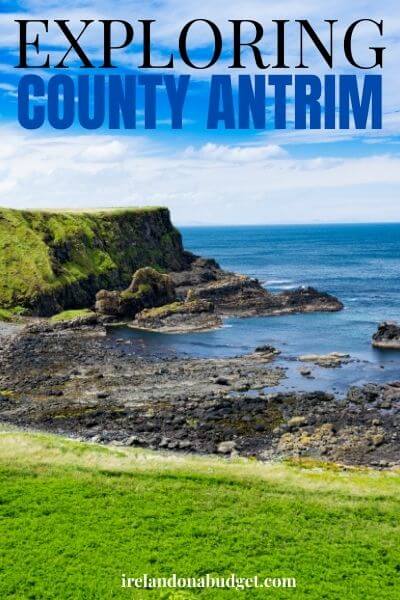 This news page contains affiliate links and I may earn compensation when you click on the links at no additional cost to you.
This news page contains affiliate links and I may earn compensation when you click on the links at no additional cost to you.
From Belfast in the eastern half of the county to the Giant’s Causeway on its northern coast, as well as the rugged beauty you’ll experience in the Glens of Antrim, there’s a whole lot to see and do in this beautiful county that is part of Northern Ireland.
The best way to see Antrim is by car.
My suggestion is to stop in Belfast first, then explore the remainder of the county.
While much of Belfast is indeed in County Antrim, the southern half of the city is in County Down.
If you’re flying into Dublin, the journey to Belfast is about two hours by car. That’s about 105 miles (168 km). You will be taking the M1 motorway much of the way and the A1 toward the end of the journey.
If you prefer not to drive, the 2 ½-hour train ride on the Enterprise from Dublin to Belfast is a great option.
If you decide to stay in Belfast for a couple of days and use that as your base, there are a number of day tours you can take from the city center that will get you to Antrim’s most popular attractions.
Here's what you can see and do when you visit Antrim.
Belfast
Despite its troubled past, Belfast is a great city to visit. The most popular attraction is Titanic Belfast dedicated to the infamous liner that sunk in the North Atlantic in 1912.
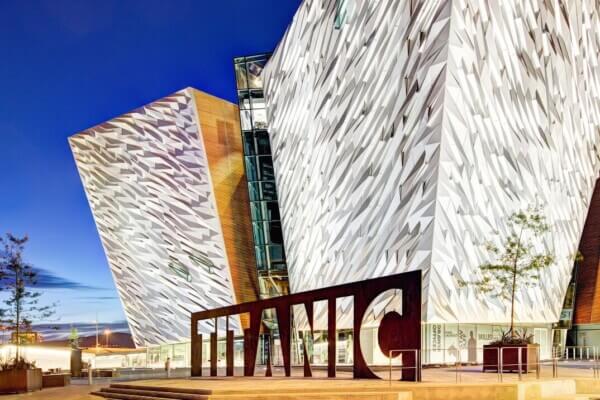
There’s a lot to see there, including multiple exhibits that tell the story of Belfast and how the great ocean liner was built.
To avoid standing in line, make sure to book a ticket in advance.
Read about my visit to the Titanic Belfast.
Other gems worth seeing in Belfast include Belfast City Hall, the Belfast Opera House, the Crumlin Road Gaol, the Ulster Museum, Belfast Castle, and a taxi tour of West Belfast.
Carrickfergus Castle
As you make your way along the Antrim coast from Belfast, don’t forget to stop at Carrickfergus Castle, a Norman castle built in 1170 by John DeCourcy.
The castle is in a picturesque location, situated in the town of Carrickfergus on the northern shores of Belfast Lough.
The castle and the town were strategically very important to the British throughout the centuries as they sought to gain control in Ireland’s northern counties.
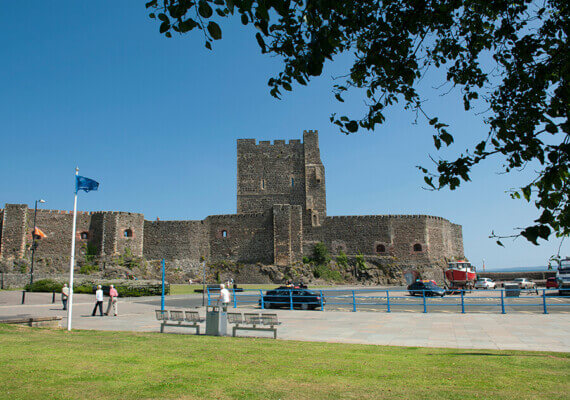
In fact, Carrickfergus was the only English stronghold north of “The Pale” (the area in and around Dublin) in the Middle Ages.
Over the centuries, this County Antrim castle was under attack from several forces, including the Irish, the French, and the Scots.
From the 18th century until the end of WWII, it also served as an armory and a prison.
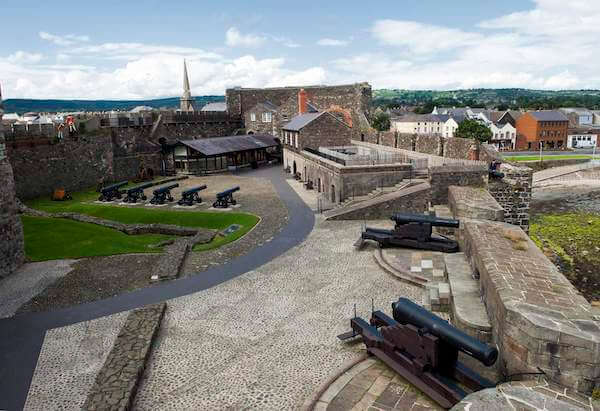
A visit to Carrickfergus Castle includes a tour of the Great Hall, which has been transformed by the recent addition of a new roof.
Admission is £6 for adults (18+); £4.50 for seniors and students with an ID; £4.50 for children aged 5-17; £18 for a family of 5, with children under 5 admitted free.
Take a Private Tour of the Antrim Coast, Including Carrickfergus Castle and The Gobbins
The Gobbins
About 20 miles in on Antrim’s Coastal Causeway you’ll find the Gobbins Path, a dramatic cliff path that was first constructed in 1902.
The attraction, a network of walkways and bridges located at the base of the cliffs and on the edge of the Irish Sea, was popular for many years. After World War II, interest in it slowly declined and in 1954, it was closed.
Thanks to a special EU fund, The Gobbins reopened in 2015 and is a favorite attraction among tourists visiting Antrim.
The one-of-a-kind cliff walk begins by going through the “Wise’s Eye,” an opening in one of the cliff rocks. You’ll make your way along narrow paths, up stairways carved into the cliff face, and through tunnels hidden under the sea.
Throughout the tour, expect to hear the story of how the Gobbins came about, as well as other fascinating tales.
Your tour guide will also talk about the geological importance of the region,
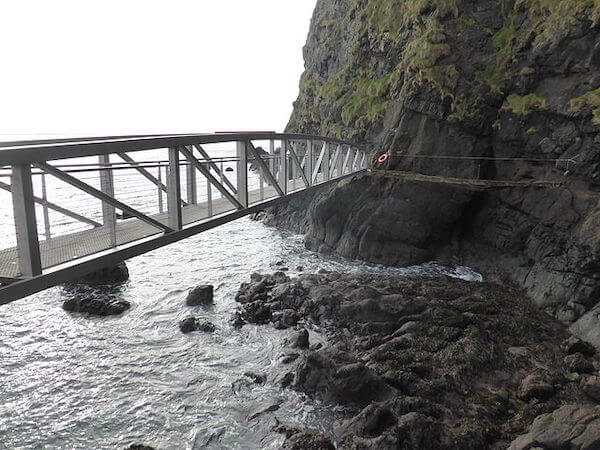
It is known for its abundance of puffins, cormorants, and dolphins.
Hard hats must be worn throughout the entire walk.
Tickets must be reserved online. Admission is £20 for adults; £14.50 for children up to age 16, as well as students and seniors, and £42 for family tickets.
Get Wifi in Ireland with Wifi Candy – take 10% off with code IOB2024
Glenarm Castle and Walled Garden
A half-hour north, still on the Coastal Causeway, you’ll find Glenarm Castle and Walled Garden.
This is the ancestral home of the MacDonnells, Earls of Antrim. It was built by the First Earl of Antrim, Sir Randall MacDonnell, in 1636. Randal, Viscount Dunluce, the son of Alexander MacDonnell, the 9th Earl of Antrim, is its current owner.
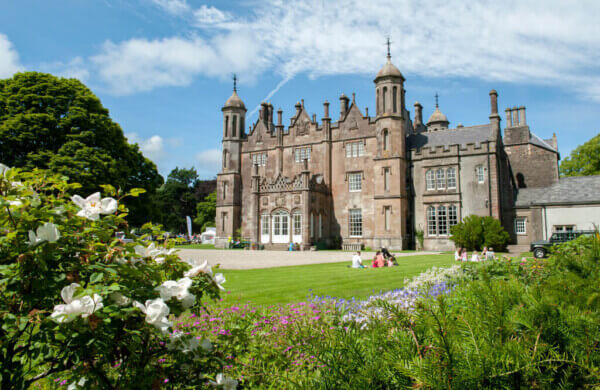
While Glenarm is privately owned, it is open to the public on select dates. Inside you’ll see a variety of fine Irish furniture as well as portraits of family members from the early 17th century onward.
The Walled Garden is one of Ireland’s oldest gardens and is a must-see.
If you've got kids with you, the Mini Land Rover Experience is a fun activity.
Glenariff Forest Park
Have you heard of the Glens of Antrim? If not, you’re in for a treat when you are visiting Antrim. Glenariff Forest Park is known as the Queen of the Glens, one of the nine Glens of Antrim.
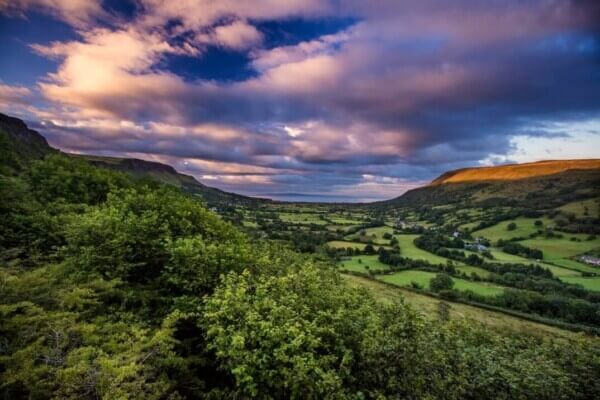
It covers close to 2,500 acres and contains planted woodland, lakes, outdoor recreation spaces, as well as areas of conservation. It is home to animals like the red squirrel, the hen harrier, and the Irish hare.
If you want to get away from it all and soak up nature when visiting Antrim, this is the place to do it.
There are several walking trails in the forest, many that will give you spectacular views of the surrounding County Antrim countryside.
The park was also one of the locations used in the Game of Thrones series.
Torr Head
The detour to Torr Head off the Coastal Causeway route is well worth the time it takes to see some spectacular views of Scotland, which is the closest you’ll get from the island of Ireland.
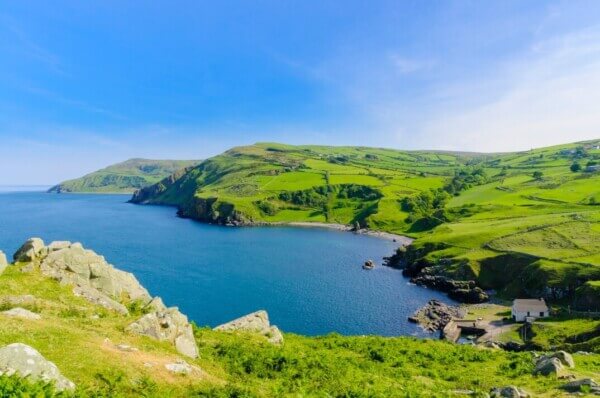
Some say it is Ireland’s most scenic sidetrack.
The road is narrow, though, with hairpin bends and blind spots, so be extra careful.
At the top of the headland is a tower that was once used to transmit messages of ship movements in the area to the Lloyds of London insurance agency.
Bonamargy Friary
The coffins of several earls of Ulster and the chieftain, Sorley Boy MacDonnell were laid to rest in this friary, which was built by Rory MacQuillan in 1500.
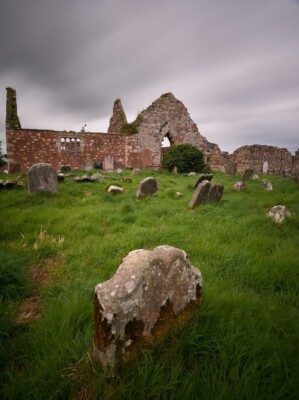
Much of the friary is quite well preserved, including its cloister, gatehouse, altar, and church. Be sure to look for the sealed burial vault, where I expect the chieftains are buried.
The friary is located on the coast road near Ballycastle, about a 17-minute drive from Torr Head. Be sure to add it to your itinerary when visiting Antrim.
The Dark Hedges
This place is synonymous with the Game of Thrones. The long pathway that leads to Gracehill House was where the scenes for the King’s Road were filmed.
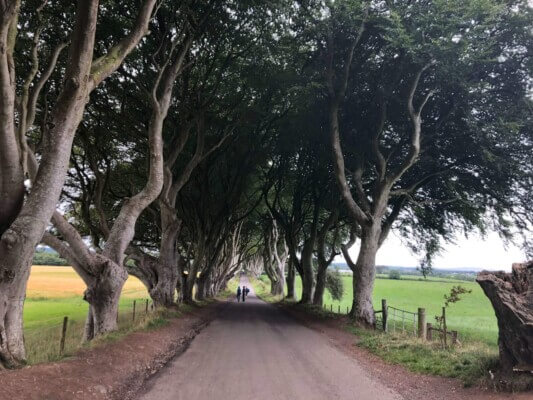
It is an iconic location for sure with its avenue of beech trees planted by the Stuart family in the 18th century.
It takes a bit of hunting to locate, however, as it is about 7 miles (11 km) from the Coastal Causeway Route.
If you’re a fan of the show, visiting this Antrim attraction is a must. It has become one of the most photographed places in Northern Ireland.
Rathlin Island
Most people visiting Antrim may not consider making the trip to Rathlin Island, which is also a part of the county.
The six-mile journey to the island starts at Ballycastle Harbor and takes you across the Sea of Moyle. It is one of several offshore islands around Ireland and Northern Ireland.
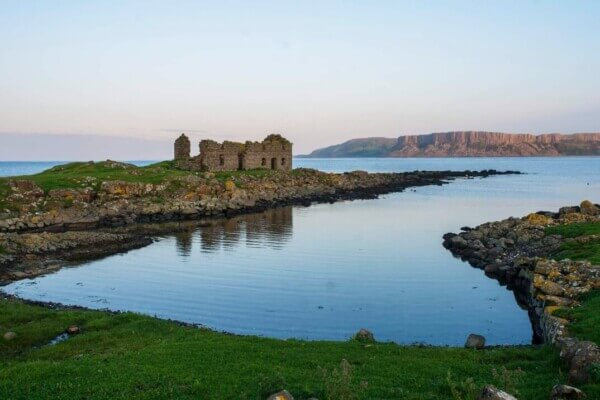
Rathlin Island is home to a large seal colony, which you will spot if you choose any one of the island’s eight walking trails.
If you’re visiting this Antrim island between April and June, you’ll likely catch a glimpse of the thriving puffin community.
Learn more about the island’s birdlife at the refurbished seabird center, which is housed in the island’s working lighthouse, Rathlin Island West.
Carrick-a-Rede Rope Bridge
There may be long lines to this attraction, but it is totally worth it.
The Carrick-a-Rede Rope Bridge was first built by salmon fishermen in 1755 to avoid taking a boat to the tiny island of Carrickarede.
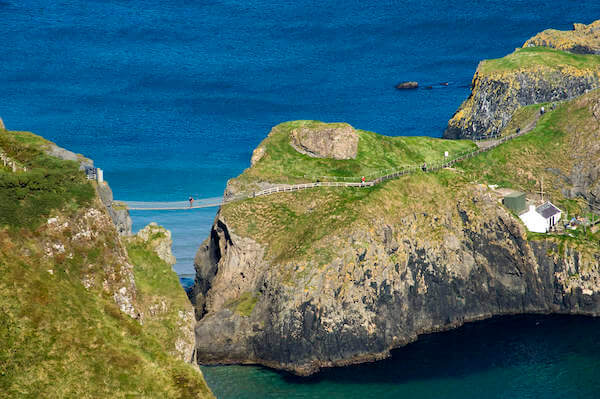
The bridge that you’ll cross over is much sturdier than the original one, handling weights of up to 10 tons. The new one was constructed with the help of local rock climbers and abseilers.
Once you get to the other side of the rope bridge, you can sit and relax for a while, taking in the natural wildlife, including the many puffins that call the island home, while taking in the views of Rathlin Island and Scotland.
Carrick-a-Rede Rope Bridge is managed by the National Trust.
Giant’s Causeway
This is by far the most popular attraction that people go to when visiting Antrim.
The Giant’s Causeway is a unique sight, famous for its unusual basalt columns left there by a volcanic eruption 50 to 60 million years ago.
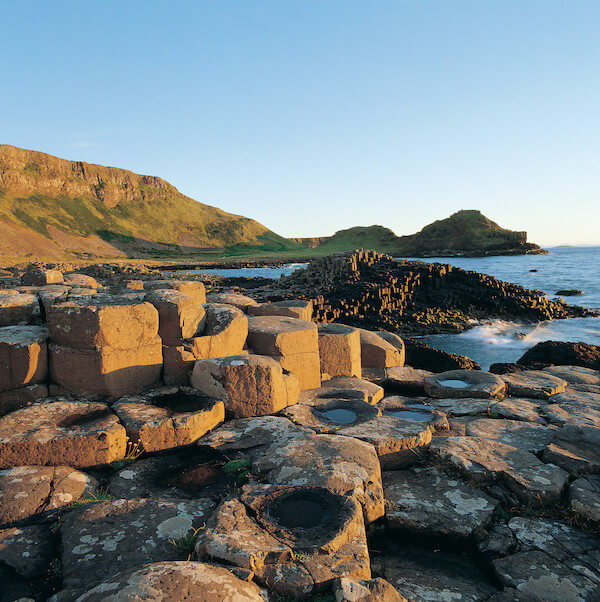
Of course, this being Ireland, the more popular explanation is that the warrior Finn MacCool got into a dispute with a Scottish giant named Benandonner, who was threatening Ireland. An angry Finn grabbed chunks of the Antrim coast and threw them into the sea, forming a path for Finn to follow to teach Benandonner a lesson.
You’ll have fun stepping from one column to the next, some as high as 12 meters (39 feet).
The Giant’s Causeway is actually free to visit, although you must pay an entrance fee if you use the nearby parking lot.

Guided tours are also available, and the visitor center will give you the history and science behind the causeway’s spectacular formations.
A visit to the Giant’s Causeway is not complete without taking a hike around this beautiful area. You can choose from four trails, known as the red, blue, green, and yellow trails.
More information on the various hikes can be found on the National Trust website.
Bushmills Whiskey Distillery
The nearby Bushmills Whiskey Distillery, about 2 ½ miles (4 km) from the Giant’s Causeway, is not the oldest whiskey distillery on the island of Ireland, although a license was granted to a local landowner as early as 1608.
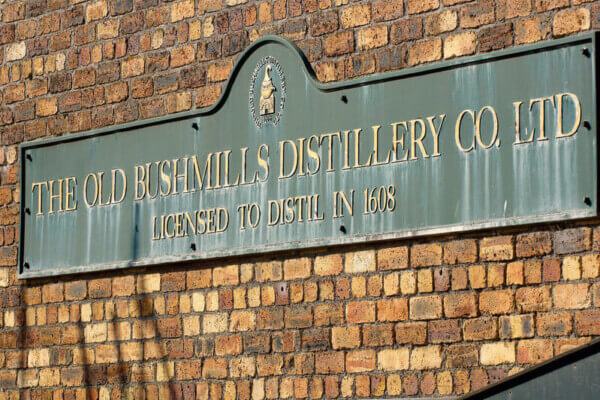
The company, however, was established in 1784, making it the oldest whiskey distillery in Northern Ireland.
When visiting Antrim, be sure to take a tour of the famous distillery, which includes information on the triple-distilling process that makes Irish whiskey different from Scotch whiskey.
You will also discover more about the whiskey maturing process, which typically takes between five and 30 years depending on the blend.
Two tours are available at Bushmills. They include a 1-hour guided walking tour of the distillery costs £15 per person while its Premium Tour and Tasting Experience costs £50 per person.

Dunluce Castle
No visit to Antrim is the same without visiting the iconic Dunluce Castle that sits precariously on a dramatic coastal cliff.
Built by the MacQuillan family around 1500, the castle’s location was so precarious that parts of the kitchen fell into the sea during a violent storm in the 1600s.
The kitchen is still intact, though, and can be found next to the manor house. You can see evidence of an oven and a fireplace when you take a tour.
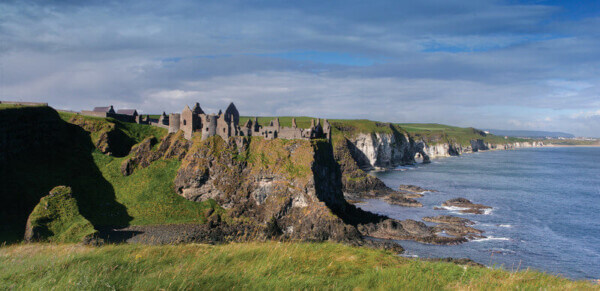
After the castle was seized by the powerful MacDonnell clan in the mid-1500s under the leadership of Sorley Boy MacDonnell, a number of reinforcements were made to the building.
Most of the walls and towers you see today were built on his orders.
Given the castle’s importance in the area, it’s not surprising that a small merchant town developed around it.
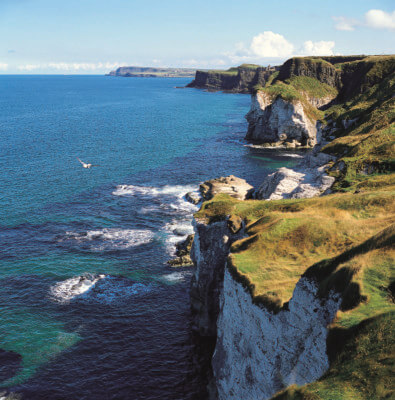
Unfortunately, evidence of the old Dunluce town is scarce, except for the findings of a recent archaeological dig.
You can read more about the history of the atmospheric Dunluce Castle when you visit, but the dramatic scenery is what most tourists are after.
Admission for adults is £6, £4.50 for students and seniors 65 and over, and £4 for children ages 5-17. Children under 5 are admitted free. A family ticket is £18.

